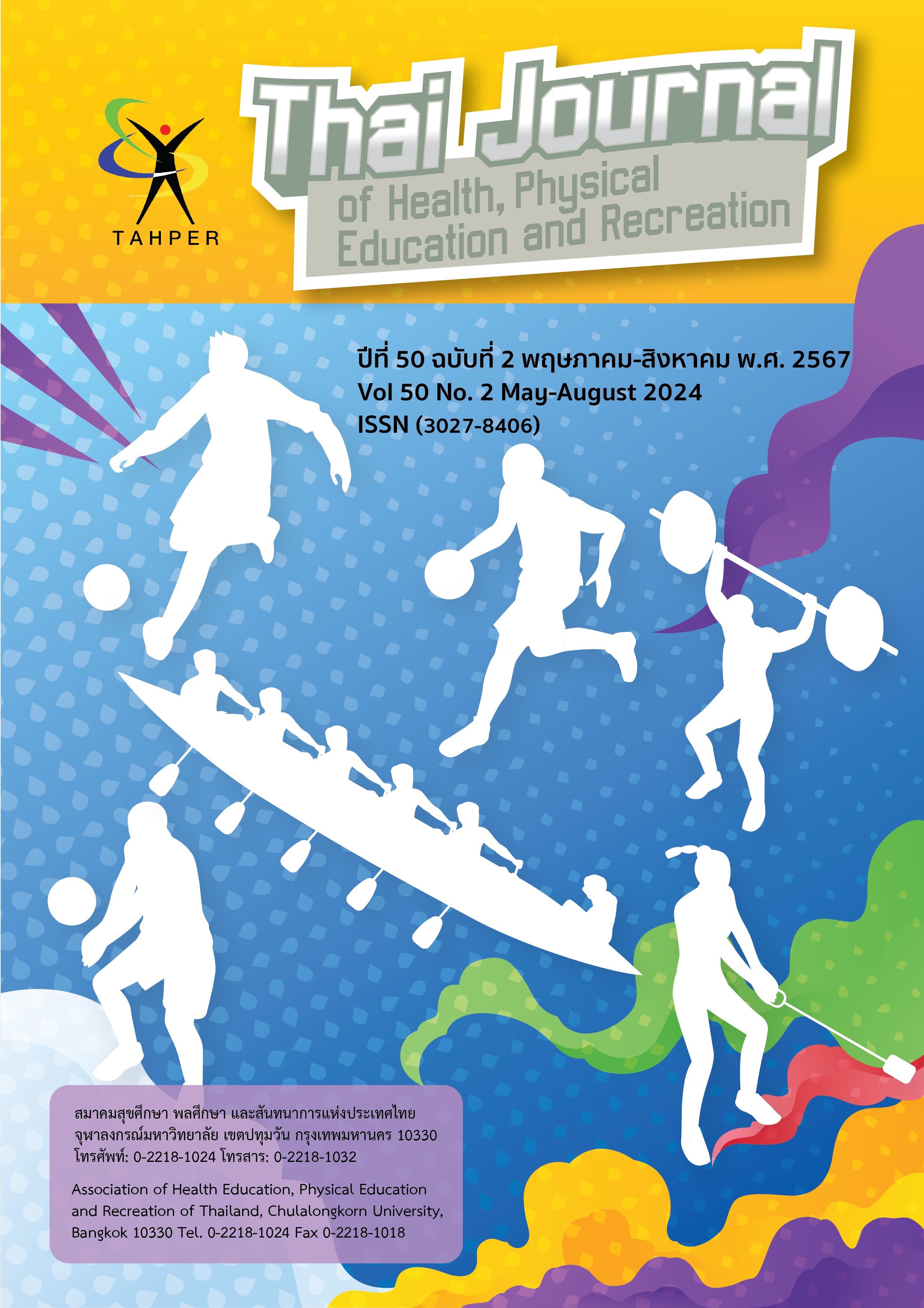The Effect of Power Yoga Training Program on Core Muscle Strength and Balance Among Female Students in Silpakorn University Sanam Chandra Palace Campus
Main Article Content
Abstract
The purpose of this research was to study and compare the effect of power yoga training program on core muscle strength and balance before and after training. The participants of this research were 20 first-year female Silpakorn University students in 2022 by purposive sampling. The tool in this research was 1) Power Yoga training program reviewed by three experts (IOC=0.98); 2) Core strength test (Plank Test) and balance test (Stork Balance Test) (IOC=0.1). Statistics used to analyze data were One-way ANOVA with Repeated Measure and BonFerroni's Method for individual differences. The research results found that firstly, the Plank test for core strength test before training, after 3 and 6week training, showed mean and standard deviation scores of 39.27 ± 13.00, 68.01 ± 22.15, 80.30 ± 18.51 seconds, respectively. The comparison of core strength revealed that after 6 weeks of training with the Power Yoga training program, the strength of the core muscles was significantly better than before training (p ≤ 0.05). Secondly, the balance test results from the Stork Balance test before training, and after the 3rd and the 6th weeks of training showed the mean and the standard deviation scores of 7.40 ± 3.13, 10.69 ± 4.24, 13.27 ± 4.37 seconds, respectively. Regarding the balance comparison, it showed that, after 6 weeks of practicing with the Power Yoga program, students had improved their balance at a statistically significant test result at the .05 level. From the research results, it could be concluded that the 6-week Power Yoga training program resulted in an increase in the participants’ muscle core strength and balance.
Article Details

This work is licensed under a Creative Commons Attribution-NonCommercial-NoDerivatives 4.0 International License.
Critical thinking in journals is the right of the author. The Association of Health Education, Physical Education and Recreation of Thailand is not always required, to create diversity in ideas and creativity.
ความคิด ข้อวิพากษ์ในวารสารเป้นสิทธิของผู้เขียน สมาคมสุขศึกษา พลศึกษา และสันทนาการแห่งประเทศไทยไม่จำเป็นต้องเห็นชอบด้วยเสมอไป เพื่อให้เกิดความหลากหลายในความคิดและความสร้างสรรค์
References
เจริญ กระบวนรัตน์. (2545). เอกสารการอบรมเชิงปฏิบัติการ เรื่อง การฝึกกล้ามเนื้อด้วยการยกน้ำหนัก. กรุงเทพฯ: คณะศึกษาศาสตร์ มหาวิทยาลัยเกษตรศาสตร์.
เจริญ กระบวนรัตน์. (2544). การฝึกกล้ามเนื้อด้วยการยกน้ำหนัก. กรุงเทพฯ: คณะศึกษาศาสตร์มหาวิทยาลัยเกษตรศาสตร์
มัลลิกา ภิรมย์บุญ, พรรณี ปึงสุวรรณ, ลักขณา มาทอ,รวยริน ชนาวิรัตน์, พลลพัฏฐ์ ยงฤทธิปกรณ์ และเสาวนีย์ นาคมะเริง. (2563). ผลของการฝึกกล้ามเนื้อแกนกลางลำตัวที่มีต่อความแข็งแรงและความทนทานของกล้ามเนื้อหน้าท้องและความสามารถในการลุกยืนในวัยรุ่นที่มีภาวะอ้วน : การศึกษานำร่อง. วารสารวิทยาศาสตร์การกีฬาและสุขภาพ, 21(3), 460-470.
เมธี ศิลา, สมบัติ อ่อนศิริ, อำนวย ตันพานิช และชาติชาย อมิตรพ่าย. (2565). ผลของการฝึกแบบสถานีที่มีต่อการพัฒนาการทรงตัวของเด็กออทิศติก. วารสารสุขศึกษา พลศึกษา และสันทนาการ, 48(1), 227-237.
สมนึก กุลสถิตพร. (2549). กายภาพบำบัดในผู้สูงอายุ. (พิมพ์ครั้งที่ 2). กรุงเทพฯ: อ็อฟเซ็ทเพรส.
สาลี่ สุภาภรณ์. (2546). แนวคิดและประสบการณ์เกี่ยวกับการฝึกไอเยนกะโยคะของคนไทยในวัยผู้ใหญ่. มหาวิทยาลัยศรีนตริทรวิโรฒ องครักษ์: ภาควิชาวิทยาษาสตร์การกีฬา.
สุคนธ์ อนุนิวัฒน์, ทศพล ธานี และสาธิน ประจัญบาน. (2562). ผลของการฝึกด้วย ที อาร์ เอ็กซ์ และการฝึกด้วยน้ำหนักของร่างกายที่มีต่อความแข็งแรงอดทนของกล้ามเนื้อ. วารสารสุขศึกษา พลศึกษา และสันทนาการ, 45(1), 274-285.
อนุกูล มะโนทน และคณะ. (2565). ผลกระทบจากการแพร่ระบาดของโควิด-19 ต่อพฤติกรรมการป้องกันโรคไวรัสโควิด-19 ของประชาชนอายุ 18-60 ปี มหาวิทยาลัยพะเยา. การประชุมวิชาการระดับชาติ ครั้งที่ 14 มหาวิทยาลัยราชภัฎนครปฐม. 7-8 กรกฎาคม 2565. หน้า 2966-2978.
เอกลักษณ์ พุฒิธนสมบัติ. (2549). การฝึกโยคะลาทิสที่มีต่อสุขภาพ. กรุงเทพฯ: มหาลัยศรีนครินทรวิโรฒ สาขาวิทยาศาสตร์การกีฬา.
ถนอมวงศ์ กฤษณ์เพ็ชร์ และกุลธิดา เชิงฉลาด. (2544). ปทานุกรมศัพท์กีฬา พลศึกษาและวิทยาศาสตร์การกีฬา. กรุงเทพ: สำนักพิมพ์แห่งจุฬาลงกรณ์มหาวิทยาลัย.
Brittenham, D.; & Brittenham, G. (1977). Stronger ads and back. United States of Amarica: United Graphics.
David, F. (2005). Strategic management: Concepts and case studies.
Gannon; & Life. (2002) Jivamukti Yoga: Practices for liberating body and soul. Ballantine Books; 2002 Apr 23.
Hedrick, A. (2000). Dynamic flexibility training. Strength & Conditioning Journal, 22(5), 33.
Kho M. and Tan J. (2006). Understanding Biomechanics for Physical Education and Sports. McGraw-Hill Education
Roberts, K. J. (2004). Yoga for golfers: a unique mind-body approach to golf fitness. McGraw-Hill.
Samokham, N., & Sitilertpisan, P. (2016). Effect of dynamic core stability exercise on physical performance in male dragon boat paddlers. Journal of Associated Medical Sciences, 49(1), 146-146.
Shumway-Cook, A., & Woollacott, M. H. (2007). Motor control: translating research into clinical practice. Lippincott Williams & Wilkins.
Yakut, H., & Talu, B. (2021). The effect of core strength training on flexibility and balance in sedentary healthy young individuals. Baltic Journal of Health and Physical Activity, 13(4), 9.


